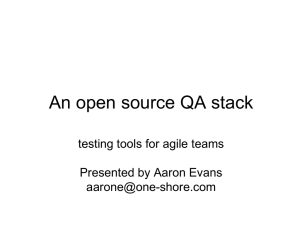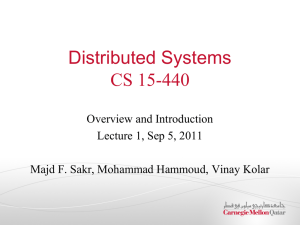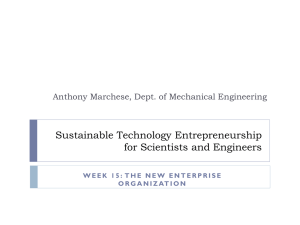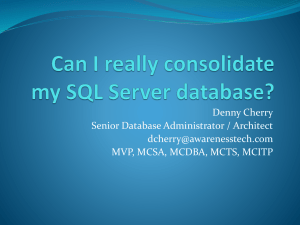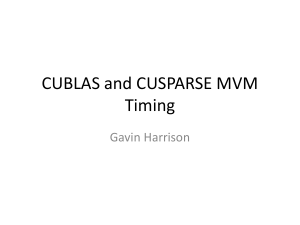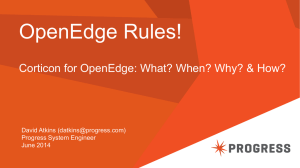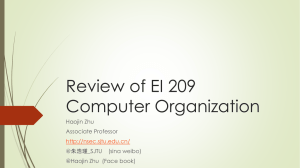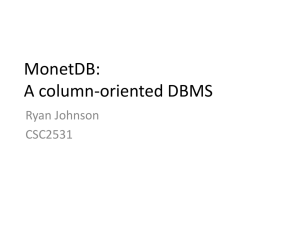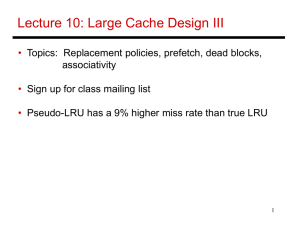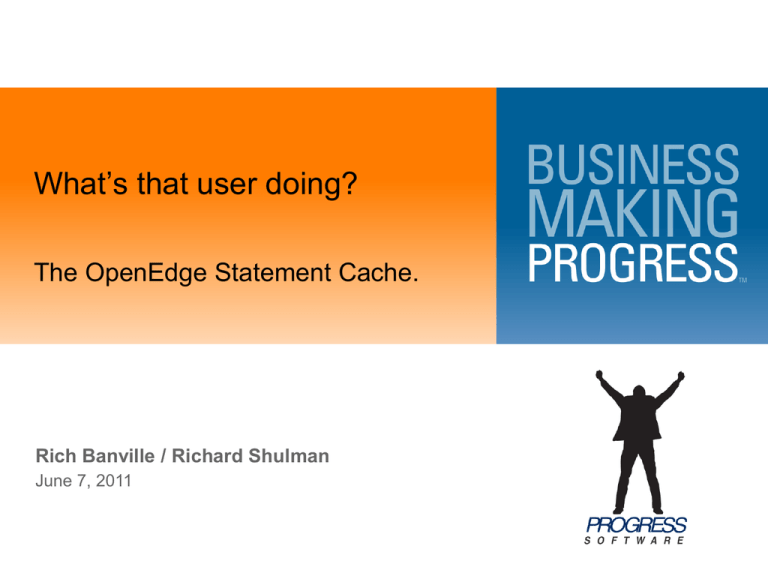
What’s that user doing?
The OpenEdge Statement Cache.
Rich Banville / Richard Shulman
June 7, 2011
Agenda
2
What is the Statement Cache
Promon access
Virtual system table visualization
Memory consumption
Performance costs
Use case examples
© 2010 Progress Software Corporation. All rights reserved.
Client Database-Request Statement Caching
What is it?
• Client execution stack trace dump
• Includes: Line #, procedure name, file name
• Introduced in 10.1C
– Not a new feature
When should you use it?
• Diagnosing deployed application problems
• Local and remote access
What’s in a name?
• Don’t confuse with other “statement caches”
Documentation
• OpenEdge Data Management: Database Administration
3
© 2010 Progress Software Corporation. All rights reserved.
Procedure Call Stack
Its just a LIFO…
Top is last procedure executed
Bottom is first procedure executed
Top down, newest to oldest
Top
Newest
Oldest
Bottom
#
Procedure Name
19 : reallyLongNamedInternalProcedure3
12 : reallyLongNamedInternalProcedure2
5 : reallyLongNamedInternalProcedure1
445 : reallyLongNamedInternalProcedure0
1 : /usr1/stmtest/p72340_Untitled1.ped
More on data format later…
4
© 2010 Progress Software Corporation. All rights reserved.
File Name
proctestb.r
proctestb.r
proctesta.r
proctesta.r
Enablement
Multi-level activation
promon R&D
1. Status Displays ...
18. Client Database-Request Statement Cache ...
Activate
1. Activate For Selected Users
2. Activate For All Users
3. Activate For All Future Users
4. Deactivate For Selected Users
5. Deactivate For All Users
6. Deactivate For All Future Users
7. View Database-Request Statement Cache
8. Specify Directory for Statement Cache Files
5
© 2010 Progress Software Corporation. All rights reserved.
Activation Types
Multi-level activation
1. Single
•
•
•
•
Report top of the stack
Last procedure call only
Better performance
Continual update
2. Stack
• Reports entire stack (31 deep, sometimes more)
• 32,000 byte maximum stack size
• Most information
– How did I get there?
• Continual update
6
© 2010 Progress Software Corporation. All rights reserved.
Activation Types
Its not a trace. It’s a current stack dump.
3. One time stack
• Full stack snapshot
• Reports stack one time (on next DB operation)
• Not continuous update
– Remembered until deactivated or reactivated
– Re-activate for update
• Diagnose quickly changing stack
Summary
•
•
•
•
7
Select, current, future users
One time vs continuous
Top of stack or full stack
SQL exception – statement level only
© 2010 Progress Software Corporation. All rights reserved.
Server Enablement
Multiple clients on same server.
Server level enablement
• Activates all currently served clients
• Remote logout/login disables it
Application server agent
• Connection based, not session based
• Setting does not follow user through to AppServer Agent
OpenEdge SQL Server
•
•
•
•
8
Same activation rules
Statement level report
Stack level does not apply
Continuousness applies
© 2010 Progress Software Corporation. All rights reserved.
Disablement
Let’s have a look at…
promon R&D
1. Status Displays ...
18. Client Database-Request Statement Cache ...
1. Activate For Selected Users
2. Activate For All Users
3. Activate For All Future Users
Deactivate
4. Deactivate For Selected Users
5. Deactivate For All Users
6. Deactivate For All Future Users
7. View Database-Request Statement Cache
8. Specify Directory for Statement Cache Files
9
© 2010 Progress Software Corporation. All rights reserved.
Disablement
promon
R&D
Deactivate
server
deactivates all users of that server.
1. Status Displays ...
12/07/10
OpenEdge Release 11 Monitor (R&D)
11:15:0318. Client
Deactivate
For Selected Users
Database-Request
Statement Cache ...
Usr
1
23
24
Name
Type For Selected
Login time
1. Activate
Users Serv IPV# Remote Address
pug11
SERV For All12/06/10
2. Activate
Users 16:19 0
usera
REMC/ABL
16:23 1 IPV4 172.12.3.456
3. Activate
For All12/06/10
Future Users
userb REMC/ABL 12/07/10 08:34 1 IPV4 172.12.3.456
4. Deactivate For Selected Users
5. Deactivate For All Users
6. Deactivate For All Future Users
7. View Database-Request Statement Cache
8. Specify Directory for Statement Cache Files
10
© 2010 Progress Software Corporation. All rights reserved.
Viewing the Statement Cache
Let’s have a look at…
promon R&D
1. Status Displays ...
18. Client Database-Request Statement Cache ...
1. Activate For Selected Users
2. Activate For All Users
3. Activate For All Future Users
4. Deactivate For Selected Users
5. Deactivate For All Users
6. Deactivate For All Future Users
View
7. View Database-Request Statement Cache
8. Specify Directory for Statement Cache Files
11
© 2010 Progress Software Corporation. All rights reserved.
Caching Types
12/07/10
11:20:50
Usr
5
23
24
25
26
OpenEdge Release 11 Monitor (R&D)
View Database-Request Statement Cache
Name
userb
userb
userb
userb
userb
Type
SELF/ABL
REMC/ABL
REMC/ABL
REMC/ABL
REMC/SQL
Login time
Serv Type Cache Update
12/07/10 09:38 0
L1 12/07/10 09:50
12/07/10 09:46 2
12/07/10 09:40 1
L2 12/07/10 09:50
12/07/10 09:40 1
RQ 12/07/10 09:50
12/07/10 09:40 3
L2 12/07/10 09:50
Type
Describes value in the cache
Remains blank if cache not populated yet
12
© 2010 Progress Software Corporation. All rights reserved.
Caching Types
12/07/10
11:20:50
Usr
5
23
24
OpenEdge Release 11 Monitor (R&D)
View Database-Request Statement Cache
Name
userb
userb
userb
Type
SELF/ABL
REMC/ABL
REMC/ABL
Login time
Serv Type Cache Update
12/07/10 09:38 0
L1 12/07/10 09:50
12/07/10 09:40 1
L2 12/07/10 09:50
12/07/10 09:40 1
RQ 12/07/10 09:50
“L1”: Level 1
• Continuous procedure at top of stack only
• “SQL Statement or Single ABL Program Name”
“L2”: Level 2
• Continuous full stack
• “SQL Statement or Partial ABL Program Stack”
“RQ”: Client Trace Request (level 3)
• One time stack
• “SQL Statement or Partial ABL Program Stack”
13
© 2010 Progress Software Corporation. All rights reserved.
OpenEdge SQL Support
12/07/10
11:25:34
OpenEdge Release 11 Monitor (R&D)
View Database-Request Statement Cache
User number
: 22
User name
: userb
User type
: REMC/SQLC
Login date/time
: 12/07/10 09:02
Statement caching type : SQL Statement or Partial ABL Program Stack
Statement caching last updated : 12/07/10 11:23
Statement cache information
: select count(*) from pub.customer
Operates on user or server level - same rules apply
• “All users” option does not indicate server specifically
Lower overhead
• Statement level entry
• No additional network traffic (all server side)
Line number not used (always 0 in VST)
14
© 2010 Progress Software Corporation. All rights reserved.
Statement Caching for ABL
12/07/10
11:25:34
OpenEdge Release 11 Monitor (R&D)
View Database-Request Statement Cache
…
Statement cache information :
2 : finalProcedure userb/my_dot_rs/longNamedDotr4.r
4 : userb/my_dot_rs/longNamedDotr3.r
4 : userb/my_dot_rs/longNamedDotr2.r
4 : userb/my_dot_rs/longNamedDotr1.r
1 : r2.r
Line #: procedure/function name, file name
• Maps to COMPILE w/DEBUG-LIST option
No internal procedure/function name, no problem
• Line # and file name only
Pathname
• Same as run command
• PROPATH not prepended
15
© 2010 Progress Software Corporation. All rights reserved.
Statement Caching for OO ABL
12/07/10
11:25:34
OpenEdge Release 11 Monitor (R&D)
View Database-Request Statement Cache
…
Statement cache information :
17 : reallyLongNamedProcedure3 proctest2.p
12 : reallyLongNamedProcedure2 proctest2.p
5 : reallyLongNamedProcedure1 proctest2.p
445 : proctest2.p
16 : methodB test13d
3 : runner.p
1 : /usr1/userb/11/stmtest/p49070_Untitled1.ped
16
Line #
Method name
Class file name without .cls extension
Example run from proc editor (note .ped)
© 2010 Progress Software Corporation. All rights reserved.
Application Server
Establish logging by user (AppServer Agent)
• Same as any other user
Tracing back
• Actions based on AppServer agent connection
• Connection/tracing maintained across session disconnect
• Difficult to identify originating user request
asbroker1.server.log
• Contains procedure call info too!
– Even at loggingLevel=1 (error only)
17
© 2010 Progress Software Corporation. All rights reserved.
Manually Generate Stack Trace
Enhanced protrace format
Stack also available via ABL dump request
• Useful for “non-responsive” connections
• Available with 10.1c
• Must have access to client’s machine
kill –SIGUSR1 <pid> (Don’t forget the dash)
• protrace.<pid>
–
–
–
–
–
–
18
Startup parameters
Execution stack (Statement cache)
** ABL Stack Trace **
** Persistent procedures/Classes **
** PROPATH **
** Databases (logical/type/physical) **
© 2010 Progress Software Corporation. All rights reserved.
Statement Caching and -1
12/07/10
11:25:34
OpenEdge Release 11 Monitor (R&D)
View Database-Request Statement Cache
…
Statement cache information :
-1 : reallyLongNamedProcedure1 proctest2.p
445 : proctest2.p
16 : methodB test13d
3 : runner.p
1 : /usr1/userb/11/stmtest/p49070_Untitled1.ped
Line # of -1
• Database action at end of procedure
• Not a specific line # in a .p
• Often the result of buffer flushing
19
© 2010 Progress Software Corporation. All rights reserved.
File Overflow Directory
Let’s have a look at…
promon R&D
1. Status Displays ...
18. Client Database-Request Statement Cache ...
1. Activate For Selected Users
2. Activate For All Users
3. Activate For All Future Users
4. Deactivate For Selected Users
5. Deactivate For All Users
6. Deactivate For All Future Users
7. View Database-Request Statement Cache
Other
20
8. Specify Directory for Statement Cache Files
© 2010 Progress Software Corporation. All rights reserved.
External Files
Location, location, location.
Setting
•
•
•
•
Default is .db directory
Set it once
New overflow files go to new location
One file per connection
Format (“/” replaced by “~”)
• Fully qualified <dbname>.<pid>.<usrnum.cst>
• usr1~pug~x.26106.5.cst OR C!~users~pug~x.40744.6.cst
Persistence
•
•
•
•
21
Created when stack > 256 bytes
Removed at disconnect
Location instance specific
No startup parameter
© 2010 Progress Software Corporation. All rights reserved.
Virtual System Table
Visualization
22
© 2010 Progress Software Corporation. All rights reserved.
VST Monitoring
_Connect. …
_Connect-CachingType
• Caching level: 01, 02, 03
• Value “requested” in promon (top, stack, one-time)
_Connect-CacheInfoType
• "ABL Program", "SQL Statement", "ABL Stack“
• Value of current stack type displayed
• “?”: stack requested and no stack yet
"ABL Program“ (01)
• Procedure and .p name displayed
"ABL Stack“ (02 & 03)
“SQL Statement” (01, 02 & 03)
23
© 2010 Progress Software Corporation. All rights reserved.
VST Monitoring
_Connect. …
_Connect-CacheLastUpdate
• Date/time of cache update
• One time stack - indicates age of information
• Continual stack – indicates time of last database request
_Connect-CacheInfo[32]
• Up to “last“ 32 stack entries
• Procedure & executing image name
– .p or .r executed (run)
– Pathname specified (not fully qualified)
_Connect-CacheLineNumber[32]
• Up to “last” 32 stack entries
• Line number of code
24
© 2010 Progress Software Corporation. All rights reserved.
Example Query
No!
FOR EACH _Connect WHERE
_Connect-CachingType <> ?:
“one-time” sets CachingType to “?” after processed.
Yes!
FOR EACH _Connect WHERE
_Connect-CacheInfoType <> ?:
CacheInfoType set when data exists, not pending.
DISPLAY _Connect-id _Connect-Usr
_Connect-CachingType
_Connect-CacheInfoType format "x(12)“
_Connect-CacheLineNumber[1] label "Line“
_Connect-CacheInfo[1]
label "Entry“
_Connect-CacheLineNumber[2] no-label
_Connect-CacheInfo[2]
no-label
END.
25
© 2010 Progress Software Corporation. All rights reserved.
VST Sidebar
All VSTs have an index (VSI)
• Find by VSI field is usually quicker
(for queries with where clause)
• Index find vs table scan
• Depends if table based or not
– Lock table is chain based
• Value always known
VSI Counts from 1
Data may count from 1 or 0
• _Connect user counts from 0
No!
FIND _Connect WHERE
_Connect-Usr = aUserId.
Yes!
FIND _Connect WHERE
_Connect-Id = aUserId + 1.
26
© 2010 Progress Software Corporation. All rights reserved.
FOR EACH _Connection:
DISPLAY _Connect-id
_Connect-Usr
END.
Connect-Id Connect-usr
1
2
3
4
5
6
7
8
9
10
11
0
1
?
?
?
5
?
?
?
9
10
Memory
27
© 2010 Progress Software Corporation. All rights reserved.
Memory Consumption
Statement cache is always “server side”
Static allocation
• 28 bytes * (–n + -Mn + 2), regardless of cache state
Dynamic allocation
•
•
•
•
288 bytes per enabled user
Allocated upon stack population
32 bytes control info, 256 bytes actual stack
SHM reserved at DB startup
– 80 bytes * (-n + -Mn + 2)
– -Mxs is used for overflow
Consumption subject to change without notice
28
© 2010 Progress Software Corporation. All rights reserved.
Memory Management
Shared memory is a…
Shared resource
• Cache protected by USR latch
Reusable resource
• Self service clients reuse the memory
• Network clients free it at disconnect
Finite resource
• -Mxs exhaustion produces no error or warning!
• Generic status of:
"Statement caching information cannot be obtained or is not available.“
29
© 2010 Progress Software Corporation. All rights reserved.
Increase Startup Parameters Online sidebar
Increase startup parameters without database restart
proutil <db> -C increaseto <params>
<params>: -L, -B, -bibufs, -aibufs, -Mxs
Increase, not decrease
New segment restrictions
• Kernel restrictions apply
• Security restrictions
– Servers: automatically attach quickly
– Self serve: attach w/db action over time
• Minimum segment size created: 128 MB
30
© 2010 Progress Software Corporation. All rights reserved.
Increase startup parameters online
Increasing excess shared memory online
proutil myDb -C increaseto -Mxs 10000
Waiting for broker connection to newly added shared memory segments.
Usr Name Type Pid
7 userb ABL 5957
The connections above have not attached to recently added shm segments.
Do you wish to recheck? (y/n)
(n): Increase params aborted because of shared memory allocation issue.
(y): Increase params increasing excess shared memory (-Mxs) from 1024 to 10000.
31
© 2010 Progress Software Corporation. All rights reserved.
Performance
32
© 2010 Progress Software Corporation. All rights reserved.
Performance: Communication
Client message coupled w/statement cache message
• Each database “update” and find request
• Each database “lock” request
– (SHARE/EXCL)
– Record/Schema
• Same stack, no new message
• Can more than double the network traffic
Server side queries
• Do not required additional messages
1: for each customer share-lock:
1: for
each customer
• Client
stack is notno-lock:
changing anyway!
2:
the_addr = address.
2:
the_addr = address.
Full
3: while
end. in use
3:
end. stack displayed if enabled
33
© 2010 Progress Software Corporation. All rights reserved.
Performance: Communication
More data can mean more messages
Network message size is –Mm
• If exceeded, multiple messages required
How to get really large messages
• Long .p names (run path) for one!
• Deep stack for another.
Help!
•
•
•
•
•
•
34
Increase –Mm (client AND server)
PROPATH to decrease “run” path length
Shorter function/procedure/file names
One-time request
Request stack top entry only
Be frugal with activation
© 2010 Progress Software Corporation. All rights reserved.
Performance Impact
Performance vs information trade off
•
•
Continuous full stack reporting
Modular programming
–
–
Improves information
Increases stack size
Let’s look at some data
35
© 2010 Progress Software Corporation. All rights reserved.
Some Numbers
Overall
2000
500
• ~5% any stack depth
0
4.37
1000
12.46
1500
12.77
Self service
2500
6.23
• I/O not an issue
• RAM disk external file
– no change
ATM 300 User Test
Network connection
• Biggest affect
• -Mm no help
Deep
• Biggest affect on network 24%
37
© 2010 Progress Software Corporation. All rights reserved.
Difference chart in %
• With and w/out caching
• Shallow vs deep stack (~3K)
• Client server vs Self Service
• With and w/out –Mm 8K
Example Use Case
38
© 2010 Progress Software Corporation. All rights reserved.
Scenario #1 - Deadlock
Situation
• Users are in deadlock
Step #1
• Look at promon lock activity
39
12/07/10
Status: Lock Table
Usr
6
7
7
6
Trans ID Type
121759
REC
121761
REC
121761
REC
121759
REC
Name
user1
user2
user2
user1
© 2010 Progress Software Corporation. All rights reserved.
Rec-id Table
8199
2
8199
2
9000
5
9000
5
Flags
X
S QH
X
S QH
Tran State
Begin
Begin
Begin
Begin
Scenario #1 - Deadlock
Statement cache already enabled
• View users in deadlock
12/07/10
11:45:34
OpenEdge Release 11 Monitor (R&D)
View Database-Request Statement Cache
Statement cache information :
22 : find-orders
x2.p
20 : process-customers x1.p
25 : x.p
x.p
12/07/10
11:45:34
OpenEdge Release 11 Monitor (R&D)
View Database-Request Statement Cache
Statement cache information :
32 : find-customers
30 : process-orders
35 : c.p
40
© 2010 Progress Software Corporation. All rights reserved.
c2.p
c1.p
c.p
Scenario #1 - Deadlock
Statement cache NOT already enabled
• Enable and wait for next occurrence
Too late to enable statement caching
• Use kill –SIGUSR1 <pid>
• cat protrace.<pid>
** ABL Stack Trace **
--> find-orders x2.p (x2.p) at line 22
process-customers x1.p (x1.p) at line 20
x.p (x.p) at line 25
** ABL Stack Trace **
--> find-customer c2.p (c2.p) at line 32
process-orders c1.p (c1.p) at line 30
c.p (c.p) at line 35
41
© 2010 Progress Software Corporation. All rights reserved.
Scenario #2 – Lock Table Overflow
Situation
• New .r code is deployed but “nothing changed”
• “Lock table overflow, increase -L on server”
Your job
• Find user doing table scan
• Try to identify where code went wrong
Step #1
• Look at promon lock activity
12/07/10
Usr
0
5
6
…
42
User
Name
pug1
userb
userb
Other: Lock Requests By User
--- Record --Locks Waits
0
0
10
1
3213
1
© 2010 Progress Software Corporation. All rights reserved.
---- Trans --- --- Schema --Locks Waits Locks Waits
0
0
0
0
0
0
0
0
0
0
0
0
Scenario #2
Enable statement cache for user
12/07/10
11:45:34
OpenEdge Release 11 Monitor (R&D)
View Database-Request Statement Cache
Statement cache information :
445 : report-customers
all_customers.p
16 : change-cust-address update_customer.p
3 : manage-cust-acct
runner.p
Track data back to user/code
Report to development
43
© 2010 Progress Software Corporation. All rights reserved.
Summary
44
Flexible enablement options
Impact noticeable on network connections
Provides remote visualization
As always, choose the best tool for the job
© 2010 Progress Software Corporation. All rights reserved.
?
Questions
45
© 2010 Progress Software Corporation. All rights reserved.
46
© 2010 Progress Software Corporation. All rights reserved.

